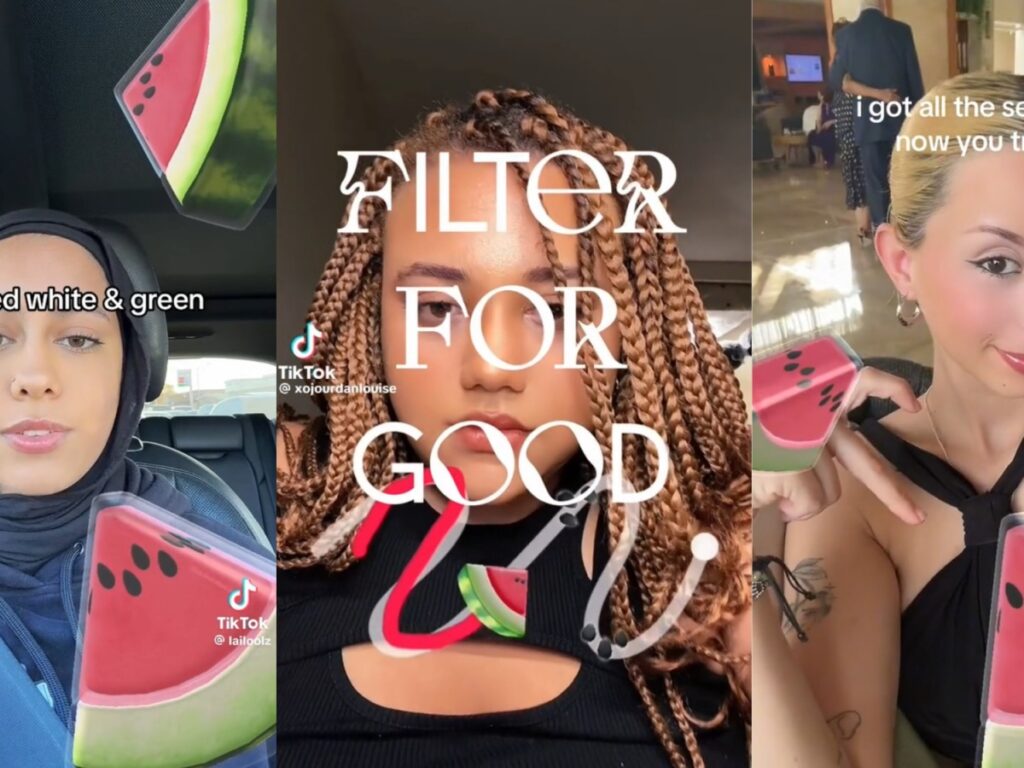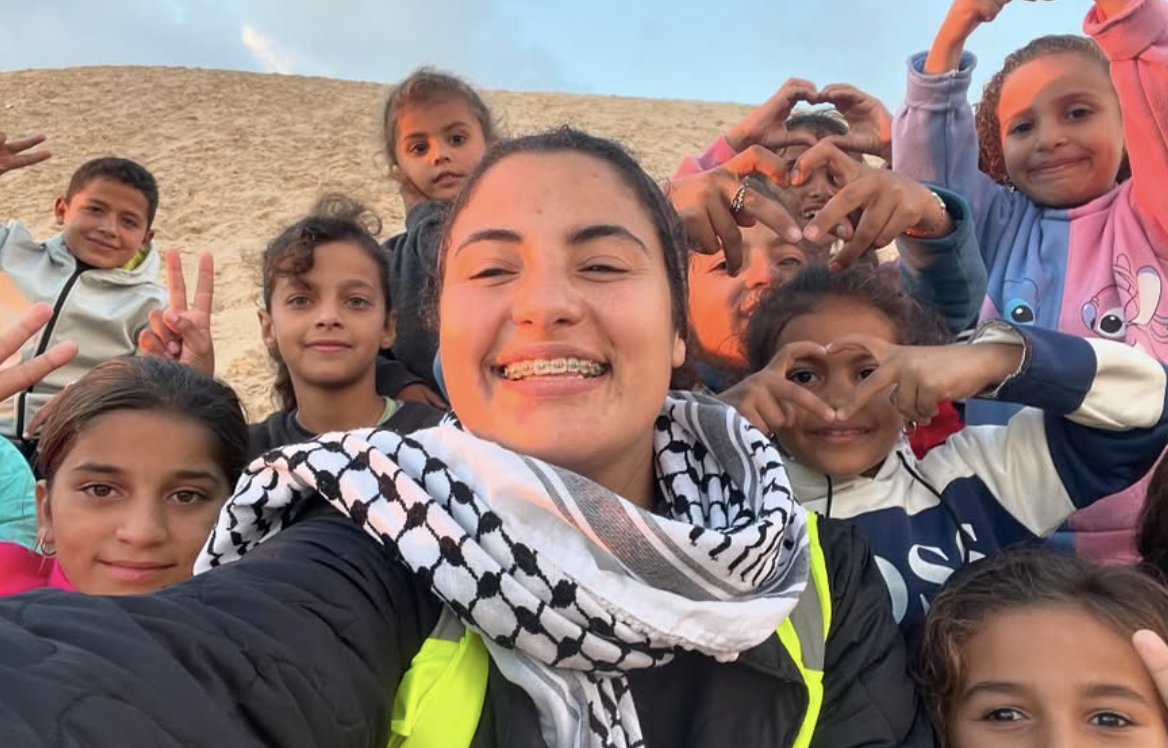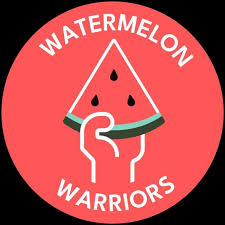Users Generate Creative Ways to Fundraise for Gaza
By Sanaa Asif
Nov/Dec 2024

In recent years, popular social media platforms such as Instagram and TikTok have emerged as powerful tools for raising awareness and supporting humanitarian causes worldwide. Theve presented information that may not appear in traditional news outlets: supported the organization of demonstrations against foreign policy and illuminated protests against human rights violations. Currently, social media is also helping in raising funds for Palestinians suffering in Gaza.
TikTok Filters Help Raise Money and Awareness for Gaza
In November 2023, one month after the genocide started, a filter named FILTER FOR GOOD started making its way into young people’s TikTok feeds. Created with augmented reality (AR) effects — digitally-added objects, text, or images that enhance the real world seen through a phone, computer, or AR headset — by designer Jourdan Johnson (@xojourdanlouise), it allows users a free and easy way to donate to Palestinians. The more a filter is used, the more money it generates. Johnson has donated all the proceeds to Doctors Without Borders and to buy eSIMs for Palestinians to stay connected.
While raising thousands of dollars, this filter has also opened a new pathway especially for young donors. Thousands of TikTok creators started making videos, filters, and sounds to donate the proceeds to Gaza. Using the watermelon emoji as a symbol of support for Palestine became popular as well, so that videos weren’t flagged or taken down.
These methods made it easy to help those in Gaza. Filming a video with a filter or sound takes less than 10 seconds; however, it could help a family evacuate. This online activism also educated many TikTokers about the conflict.
The grassroots collective Operation Olive Branch (@operationolivebranch), a volunteer-led and global solidarity initiative with over 450K followers, soon became a main source of updates and information. Providing followers with easy ways to donate, receive updates on Palestinian families and gain knowledge on the war’s general history, it has raised awareness and gained support for Palestine.
Additionally, many Gazans have now turned to TikTok to raise donations directly. Palestinian families have created their own filters and sounds, and regularly post them on TikTok asking for contributions to their GoFundMe accounts. Many TikTokers use this platform to donate directly to those accounts by interacting with their videos, using their filters, and creating sounds to help them generate money.
Instagram Gathers Support

Many of these activism techniques are available on Instagram. Palestinian families and those trying to raise funds for organizations in Palestine turn to the reels feature, short videos similar to TikToks, to gain support. Instagram users interact with these videos to generate money for the creator, and often share these videos on their public stories to raise awareness and increase donations.
Instagram is also a central platform for journalists and press in Gaza. Bisan Owda (@wizard_bisan1), a journalist who has been documenting her life of displacement in Gaza, has accumulated over 4 million followers since October 2023. Her activism has reached many, and her account has allowed supporters to track her life and truly understand the conditions in Gaza.
Palestinian photojournalist Motaz Azaiza (@motaz_azaiza) is another key figure in spreading awareness via Instagram.. Although he evacuated Gaza in January 2024, his work reporting under Israel’s bombardment gathered him over 17 million followers and an extremely large amount of support. His photos of life during the genocide have been shared in thousands of stories, bringing more support and awareness to the ongoing issue. .
Let’s Talk Palestine (@letstalkpalestine), an organization dedicated to conveying accurate information about the conflict’s background, has almost 1 million followers. With posts such as Israeli Apartheid for Beginners, A Guide to Boycotting for Palestine, and numerous ways to donate to and support Palestinians, the account is a key player in educating Instagram users. Their broadcast channel contains daily updates on Palestine.
Additionally, many such activist organizations establish their home base on Instagram. National organizations such as Hearts in Gaza Project, Operation Olive Branch, and Doctors Without Borders use it as a central point of their platform, by reaching a wide audience and directing them to their website via their accounts. One of these organizations, Watermelon Warriors (@watermelonwarriors.io), uses Instagram as one of its main platforms.
How Using Social Media Platforms Benefits Organizations

Watermelon Warriors is a Palestinian-run nonprofit that works to distribute eSIMs in Gaza. Adan (who chose not to reveal her last name to protect her family in Gaza), one of the cofounders, explains how she partnered with a friend working in tech to build the organization.
“We grew up in Wisconsin and we went to the same undergrad. He started Watermelon Warriors (WW) because he has a tech background,” she says. Originally, WW was an organization that helped people advocate for Palestinians by sending letters to representatives.
However, a few months later Adan came across the eSIM initiative, which is a digital SIM that activates a cellular plan from a carrier without having to use a physical SIM. She decided to host a fundraiser in her community to purchase eSIMs for Palestinians, but soon realized that they were very expensive. “The previous eSIMs that I was purchasing were about 10 gigabytes with 30-day activation rates for about $65 each,” Adan recalls. “I was posting the progress, and my friend had reached out to me and said, ‘I have a tech background. I think we can do this more efficiently.’” The two friends collaborated to eventually build the organization it is today.
Today, supporters can donate an eSIM to journalists, doctors, and civilians in Gaza for only $17. “We purchase the eSIMs, download the QR codes, and send our brothers and sisters in Palestine a photo of each QR code. We can do that through WhatsApp and Instagram,” Adan explains.
Although WW also has a website and Twitter and Tumblr accounts, Instagram has allowed them to reach a wider audience. “We just found that Instagram has the widest reach for us since we’re able to communicate with not just our distributors, but also people in need and are able to explain the process that way,” Adan said. “Our website is a good landing page for people to donate, but social media helps spread the word.”
WW currently has over 12K followers on Instagram and consistent post engagement. “We find that people share our posts [on] a lot of their stories,” Adan states. “We also found that a lot of people take our posts and then host fundraisers of their own within their communities. And they’re able to raise hundreds of dollars at a time to donate eSIMs, which has been really special. And we’re so grateful for it.”
The organization also prioritizes educating their supporters. “We’re trying to have more informative posts moving forward with historical information so people are able to educate themselves and share that information with others,” Adan says.
Most members of WW’s current audience are licensed professionals. “Doctors, teachers, community members, especially a lot of psychologists, have been reaching out to promote us and ask how they can help. We’re finding a lot of 30–50-year-old professionals willing to help,” Adan said.
Since Adan is based in Texas and her partner in Chicago, the organization relies heavily on volunteer support. “Our volunteers are all over the world – one in Germany, one in Spain, obviously our distributors in Palestine, and then a bunch around America who, if they have a minute, will create a post for us and help us keep up a regular social media schedule,” Adan says. “So, it takes a village, and we’re so grateful for all the volunteers for even donating a little bit of time and effort to help us.”
What You Can Do to Help
Large social media platforms such as Instagram and TikTok have enabled users to donate to Palestinians, even if they may not be able to afford to donate money directly. Liking, sharing, and commenting on more than nine words on videos from the accounts of Palestinian families can generate money for their account and make their videos reach a wider audience. Using filters and sounds created to donate to Gaza can also help generate thousands of dollars and help evacuate families from the apartheid system. Additionally, sharing these videos and content on your public social media accounts can increase awareness and, potentially, donations.
Sanaa Asif, a senior at Hinsdale (Ill.) Central High School, is an avid reader and loves to learn and write about others and their experiences.
